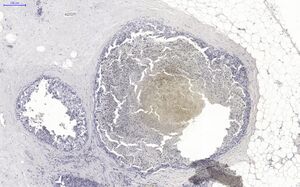13. Calcification in breast cancer (Kossa reaction): Difference between revisions
(Created page with "'''Staining''': Kossa staining '''Organ''': Breast tissue '''Description''': Several dilated ducts can be seen in the parenchyme. Surrounding the parenchyme is adipose tissue. In the middle of the ducts there is accumulation of a yellowish-brownish pigment. Cells in the middle of the ducts have pale and faded nuclei. '''Diagnosis''': Ductal carcinoma in situ (DCIS) '''Theory''': DCIS is a type of precancerous lesion, a sign that can be seen in the stages before a m...") |
No edit summary |
||
| Line 1: | Line 1: | ||
'''Staining''': Kossa staining | [[File:Calcification in the breast - overview.jpg|thumb|Another weird-looking slide]]'''Staining''': Kossa staining | ||
'''Organ''': Breast tissue | '''Organ''': Breast tissue | ||
'''Description''': | '''Description''': Several dilated ducts can be seen in the parenchyme. Surrounding the parenchyme is adipose tissue. In the middle of the ducts there is accumulation of a yellowish-brownish pigment. Cells in the middle of the ducts have pale and faded nuclei. | ||
Several dilated ducts can be seen in the parenchyme. Surrounding the parenchyme is adipose tissue. In the middle of the ducts there is accumulation of a yellowish-brownish pigment. Cells in the middle of the ducts have pale and faded nuclei. | |||
'''Diagnosis''': Ductal carcinoma in situ (DCIS) | '''Diagnosis''': Ductal carcinoma in situ (DCIS) | ||
| Line 13: | Line 11: | ||
DCIS is a type of precancerous lesion, a sign that can be seen in the stages before a malignant cancer is formed, in this case breast cancer. In DCIS the ducts lumens in the breast tissue are filled with tumor cells. The cells in the middle of the lumen receive the least oxygen and nutrients (because there are no blood vessels inside the lumen), so the cells closest to the middle of the lumen are most necrotic. Necrosis always leaves sodium, water and calcium, the latter in this case causes calcification. | DCIS is a type of precancerous lesion, a sign that can be seen in the stages before a malignant cancer is formed, in this case breast cancer. In DCIS the ducts lumens in the breast tissue are filled with tumor cells. The cells in the middle of the lumen receive the least oxygen and nutrients (because there are no blood vessels inside the lumen), so the cells closest to the middle of the lumen are most necrotic. Necrosis always leaves sodium, water and calcium, the latter in this case causes calcification. | ||
The calcification is clinically important in this case because it is visible in mammography, so it can be used during screening to determine if the patient is on the way to developing breast cancer. | The calcification is clinically important in this case because it is visible in mammography, so it can be used during screening to determine if the patient is on the way to developing breast cancer. Kossa staining is specific for calcification. Calcium deposits become yellowish-brownish with this stain. This calcification is a type of dystrophic calcification (in contrast to metastatic calcification), meaning that it associated with necrosis and not with the calcium level in the blood.[[File:Calcification in the breast - calcified duct.jpg|thumb|Close-up of a calcified duct. Note how calcification is seen only in the middle of the duct.|left]] | ||
Kossa staining is specific for calcification. Calcium deposits become yellowish-brownish with this stain. | |||
This calcification is a type of dystrophic calcification (in contrast to metastatic calcification), meaning that it associated with necrosis and not with the calcium level in the blood. | |||
[[File:Calcification in the breast - calcified duct.jpg | |||
[[File:Calcification in the breast - nucleus loss.jpg|center|thumb|In this picture you can start to see how cells gradually lose their nuclei as they approach the centre of the lumen]] | [[File:Calcification in the breast - nucleus loss.jpg|center|thumb|In this picture you can start to see how cells gradually lose their nuclei as they approach the centre of the lumen]] | ||
[[File:Calcification in the breast - necrotic area in lumen.jpg|center|thumb|Close-up of the necrotic area in the centre of the lumen.]] | [[File:Calcification in the breast - necrotic area in lumen.jpg|center|thumb|Close-up of the necrotic area in the centre of the lumen.]] | ||
[[Category:Pathology 1 - Histopathology slides]] | [[Category:Pathology 1 - Histopathology slides]] | ||
Latest revision as of 11:18, 5 July 2024

Staining: Kossa staining
Organ: Breast tissue
Description: Several dilated ducts can be seen in the parenchyme. Surrounding the parenchyme is adipose tissue. In the middle of the ducts there is accumulation of a yellowish-brownish pigment. Cells in the middle of the ducts have pale and faded nuclei.
Diagnosis: Ductal carcinoma in situ (DCIS)
Theory:
DCIS is a type of precancerous lesion, a sign that can be seen in the stages before a malignant cancer is formed, in this case breast cancer. In DCIS the ducts lumens in the breast tissue are filled with tumor cells. The cells in the middle of the lumen receive the least oxygen and nutrients (because there are no blood vessels inside the lumen), so the cells closest to the middle of the lumen are most necrotic. Necrosis always leaves sodium, water and calcium, the latter in this case causes calcification.
The calcification is clinically important in this case because it is visible in mammography, so it can be used during screening to determine if the patient is on the way to developing breast cancer. Kossa staining is specific for calcification. Calcium deposits become yellowish-brownish with this stain. This calcification is a type of dystrophic calcification (in contrast to metastatic calcification), meaning that it associated with necrosis and not with the calcium level in the blood.



